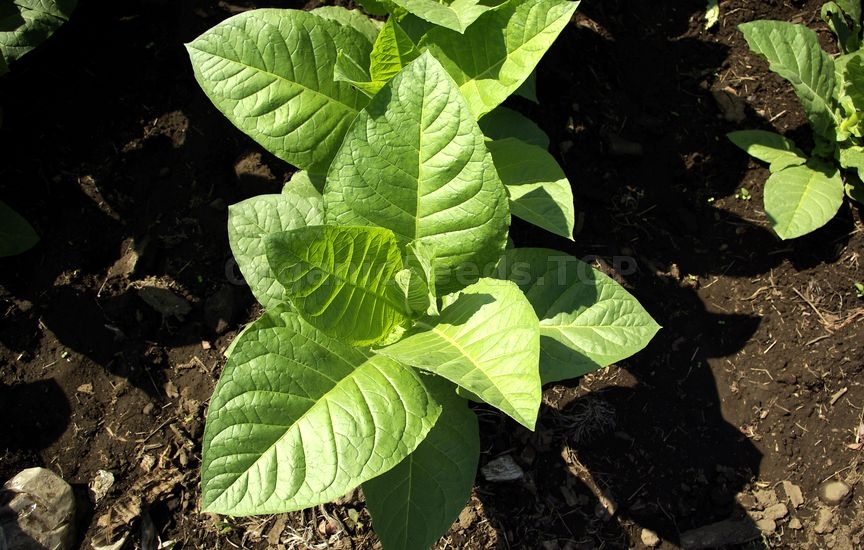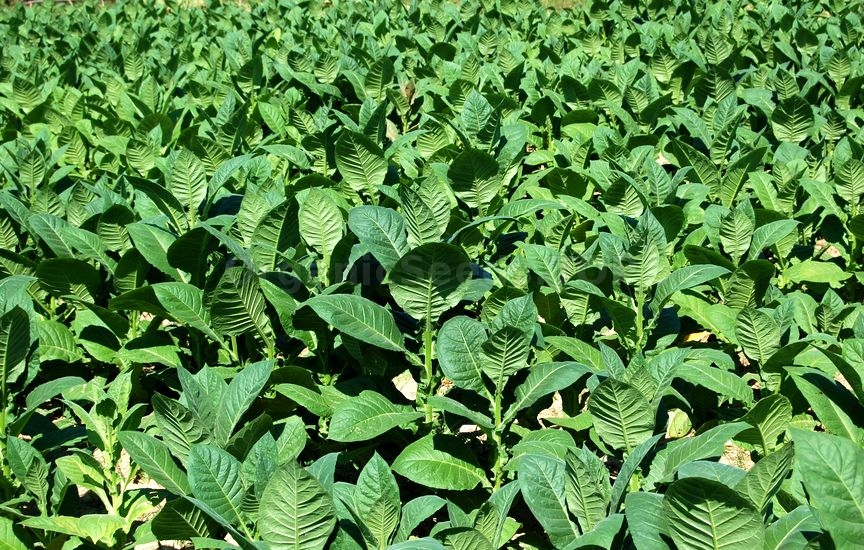How to Grow Tobacco |
 As tobacco has absolutely no food value and is not a particularly handsome ornamental, growing it would have to be a hobby for someone with a strong yen for smoking home-grown tobacco. Growing it is not much of a problem but, as the University of Florida’s Institute of Food and Agricultural Sciences reminds us, you’re going to need facilities to cure, age, and process the tobacco leaves after you grow and harvest them. Moreover, you’ll need either a building with good air circulation or a place where you can control temperature and humidity during the several weeks needed to cure the leaves. Get seeds These can be obtained from one of several seed companies specializing in tobacco; try searching for them on the Internet. Start the seeds in flower pots in a greenhouse or protected area 60 days before they are to be transplanted to a garden. Keep the soil moist but not wet.
Transplant When the shoots are about 6-8 inches in length and frost danger is past, they should go into a sunny location in the garden, spaced about two feet apart. The soil should have a pH around 5.8 and must be well drained. If lime is needed to raise the pH, use dolomite in order to get the magnesium nutrient which is important for plant growth. Poor growth and some growth disorders may occur if the soil pH is about 6.5 or more.
Avoid planting tobacco on soil infested with nematodes and diseases. Do not plant tobacco on the same soil more than once every four to five years. Instead, rotate the tobacco with plants that are not susceptible to common soil-borne pests of tobacco. Fertilize Fertilizers for tobacco could be the same fertilizers used for tomato, pepper, or potato. As in plant production, the fertilizer should contain little or no chlorine and most of the nitrogen should be in the nitrate form. In general, it would be best to apply the fertilizer in several applications.
Some could be applied to the soil before transplanting, but do not place it where it will be in high concentration around the roots of the transplants. The total amount of fertilizer to apply will depend on the grade of the fertilizer, the natural or residual fertility of the soil, losses of soluble nutrients by leaching, and perhaps other factors. A tobacco fertilizer should contain little or no chlorine and most of the nitrogen should be in the nitrate form. Fertilizer manufactured for use on tomato, pepper, and potato should be satisfactory for tobacco. If adequately fertilized up to the time of flowering, there should be no need to add any more fertilizer after the flowers begin to form. Irrigate Keep the plants well-watered without getting the soil soggy. Drought stress could limit growth on excessively drained soils unless irrigation is provided. Lack of sun will result in spindly plants, poor growth and thin leaves. Some types of tobacco such as that used for cigar wrappers are grown under some shade to promote desirable leaf characteristics.
Control pests Avoid nematode and other soil pest problems by proper soil selection and rotation. Weeds can be controlled by hoeing or pulling. The most common insect problems expected would be budworms, aphids and hornworms. Diseases that damage tobacco may include those that attack other plants or they may be specific pathogens for tobacco. Identify the pest problem and consult the appropriate pest control guide for information.
Topping and Suckering Tobacco should normally be topped as soon as the flower forms. Topping, or removal of the terminal bud, allows the upper leaves to get larger and thicker than they would in an uptopped condition. The top can be removed by breaking it out or cutting it off, preferably before any flowers open. Soon after the top is removed (before, if topping is delayed), axillary buds or suckers develop at each leaf. These will reduce yield and quality if not removed by hand when they exceed about an inch in length.
Harvesting and Curing A deterrent to home production of tobacco is the need to age the cured tobacco for one to three years or longer. Tobacco may be cured with heat added or it may be air cured. There does not appear to be any practical means for the gardener to use heat to cure the tobacco because of the facilities that are required. Some producers of home-grown tobacco have built curing facilities and may offer them for sale.
Tobacco could be cured without heat if a building with good air circulation is available. Temperatures for air curing may range from 60-65°F up to 90-95°F, and the relative humidity of the air should be about 65-70 percent. Proper curing should take a few weeks in order to have good quality. Tobacco that cures too fast will be green and not have good aroma and flavor, while mold or rot may develop if curing is slow. A building that can be opened and closed as needed to control the relative humidity and drying rate is desirable. Curing procedures need to be developed for individual situations.  Tobacco can be harvested by either removing leaves from the stalk in the field and curing them or by cutting the stalk off at ground level and hanging the entire stalk in the curing facility for the leaves to cure. The leaves would then be removed from the stalk after they have cured. If the leaves are removed in the field, there should be four or five harvests at intervals of 1-2 weeks, starting with the lower leaves. The first harvest would be at or soon after topping and when the leaves show a slight yellowing. If the entire stalk is cut for curing, it should be about 3-4 weeks after topping. The lower leaves would be partially deteriorated at this time. Provide adequate space between stalks to allow for satisfactory drying of the leaves. Aging All commercial tobacco is aged for a year or more before it is used. Unaged tobacco is harsh and does not have good flavor. For the home gardener, aging will probably be at least as difficult as proper curing. Aging may require as long as 5-6 years and does not occur unless temperature and moisture conditions are favorable. If the tobacco is too dry, there is no aging; if it is too moist, the leaves will rot. Unfortunately the proper temperature and moisture content vary widely. The home producer would need the knowledge and skill to properly age the tobacco or be willing to experiment with the process. The same would be true for adding flavoring agents during or after aging and before the tobacco is used. You may need:Organig Tobacco Seeds«Virginia» Heirloom Tobacco Seeds«American 63» - Organic Tobacco Seeds«Ukrainian Makhorka» - Organic Tobacco Seeds«Havana» Heirloom Tobacco Seeds |
|
|
